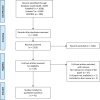Anti-Müllerian hormone for the diagnosis and prediction of menopause: a systematic review
- PMID: 36651193
- PMCID: PMC10152172
- DOI: 10.1093/humupd/dmac045
Anti-Müllerian hormone for the diagnosis and prediction of menopause: a systematic review
Abstract
Background: The early onset of menopause is associated with increased risks of cardiovascular disease and osteoporosis. As a woman's circulating anti-Müllerian hormone (AMH) concentration reflects the number of follicles remaining in the ovary and declines towards the menopause, serum AMH may be of value in the early diagnosis and prediction of age at menopause.
Objective and rationale: This systematic review was undertaken to determine whether there is evidence to support the use of AMH alone, or in conjunction with other markers, to diagnose menopause, to predict menopause, or to predict and/or diagnose premature ovarian insufficiency (POI).
Search methods: A systematic literature search for publications reporting on AMH in relation to menopause or POI was conducted in PubMed®, Embase®, and the Cochrane Central Register of Controlled Trials up to 31 May 2022. Data were extracted and synthesized using the Synthesis Without Meta-analysis for diagnosis of menopause, prediction of menopause, prediction of menopause with a single/repeat measurement of AMH, validation of prediction models, short-term prediction in perimenopausal women, and diagnosis and prediction of POI. Risk-of-bias was evaluated using the Tool to Assess Risk of Bias in Cohort Studies protocol and studies at high risk of bias were excluded.
Outcomes: A total of 3207 studies were identified, and 41, including 28 858 women, were deemed relevant and included. Of the three studies that assessed AMH for the diagnosis of menopause, one showed that undetectable AMH had equivalent diagnostic accuracy to elevated FSH (>22.3 mIU/ml). No study assessed whether AMH could be used to shorten the 12 months of amenorrhoea required for a formal diagnosis of menopause. Studies assessing AMH with the onset of menopause (27 publications [n = 23 835 women]) generally indicated that lower age-specific AMH concentrations are associated with an earlier age at menopause. However, AMH alone could not be used to predict age at menopause with precision (with estimates and CIs ranging from 2 to 12 years for women aged <40 years). The predictive value of AMH increased with age, as the interval of prediction (time to menopause) shortened. There was evidence that undetectable, or extremely low AMH, may aid early diagnosis of POI in young women with a family history of POI, and women presenting with primary or secondary amenorrhoea (11 studies [n = 4537]).
Wider implications: The findings of this systematic review support the use of serum AMH to study the age of menopause in population studies. The increased sensitivity of current AMH assays provides improved accuracy for the prediction of imminent menopause, but diagnostic use for individual patients has not been rigorously examined. Prediction of age at menopause remains imprecise when it is not imminent, although the finding of very low AMH values in young women is both of clinical value in indicating an increased risk of developing POI and may facilitate timely diagnosis.
Keywords: AMH; anti-Müllerian hormone; fertility; menopause; ovarian reserve; premature ovarian insufficiency.
© The Author(s) 2023. Published by Oxford University Press on behalf of European Society of Human Reproduction and Embryology.
Conflict of interest statement
S.M.N. has received grants from CSO, ESHRE, and MRC; consulting fees from Access Fertility, Coopers Genomics, Ferring, Merck, Modern Fertility, and TFP; speaker’s honoraria from Ferring, Merck, and Roche Diagnostics; payment for expert testimony from Medical Defence Work; and support for attending meetings from Ferring and Merck. S.M.N. has personally invested in TFP. R.A.A. has received consulting fees from Ferring, NeRRE Therapeutics, Roche Diagnostics, and Sojournix Inc; payment from Merck and IBSA for educational events; and laboratory materials from Roche Diagnostics. S.D. has been an investigator for Ovoca Bio and Que Oncology with funding paid to her institution, Monash University. She has received consulting fees from Lawley Pharm, Que Oncology, and Southern Star Research and speaker’s honoraria from Besins Healthcare, Biosyent, and Biofemme. She has participated in advisory boards for Abbott, Astellas, Mayne Pharma, and Theramex and has a leadership role in the International Menopause Society. M.A.L. is the CEO of the International Federation of Gynaecology and Obstetrics (FIGO). N.P. and S.K. have no other disclosures to make.
Figures





References
-
- Almog B, Shehata F, Suissa S, Holzer H, Shalom-Paz E, La Marca A, Muttukrishna S, Blazar A, Hackett R, Nelson SM. et al. Age-related normograms of serum antimullerian hormone levels in a population of infertile women: a multicenter study. Fertil Steril 2011;95:2359–2363, 2363.e1. - PubMed
-
- American College of Obstetricians and Gynecologists. The use of antimüllerian hormone in women not seeking fertility care. Journal Obstet Gynecol2019;133:840–841. - PubMed
-
- Anagnostis P, Christou K, Artzouchaltzi AM, Gkekas NK, Kosmidou N, Siolos P, Paschou SA, Potoupnis M, Kenanidis E, Tsiridis E. et al. Early menopause and premature ovarian insufficiency are associated with increased risk of type 2 diabetes: a systematic review and meta-analysis. Eur J Endocrinol 2019a;180:41–50. - PubMed
-
- Anagnostis P, Siolos P, Gkekas NK, Kosmidou N, Artzouchaltzi AM, Christou K, Paschou SA, Potoupnis M, Kenanidis E, Tsiridis E. et al. Association between age at menopause and fracture risk: a systematic review and meta-analysis. Endocrine 2019b;63:213–224. - PubMed
Publication types
MeSH terms
Substances
LinkOut - more resources
Full Text Sources
Medical
Research Materials

